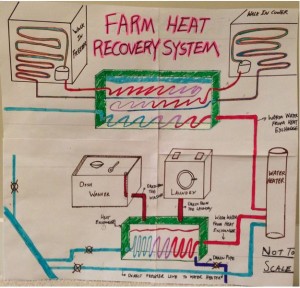Project Implementation
We are on the final stages of completing our report for the UBC Farm centre. Certain aspects of our research have proven to be difficult to complete. More specifically, our evaluation of energy flow and heat production in a kitchen could not be accurately quantified. Because the Farm’s commercial kitchen is still in the early planning stages, we have been required to make assumptions, resulting in less precise research than we initially planned. Nonetheless, we were able to complete these tasks by modifying our plan: rather than using specific numbers that may be inaccurate, we chose to compare various appliances in relation to each other. In this way, we have been still able to use this research to justify our heat recovery designs. Our conceptual designs have been finalized; to ensure our designs are feasible, we have received external input from an expert in heating and refrigeration systems.
Final Design Summary:
Our primary goal was to create conceptual designs to recover heat from the future farm centre’s commercial kitchen. As steps to complete this design, we studied appliances that will be used in the farm centre to determine the best sources of recoverable heat and the most effective uses of the recycled heat.
Water was selected to receive the recycled heat; it will absorb heat more efficiently than air and it will be used year-round. The walk in freezer, cooler, dishwasher and laundry machine produce significant amounts of recoverable heat. As shown in the sketch below, the components of these appliances that emit heat will be contained in an insulated container full of highly heat conductive fluid. Pipes carrying fresh water to the water heater will also pass through this container to be preheated before reaching the water heater. This will reduce the amount of energy required by the water heater to raise the temperature of the water.

Heat Recovery Design Sketch (higher temperature is indicated by the colour red, lower temperature is indicated by the colour blue)
Project Outcomes
Next week, we will be submitting a report to our client with the following contents:
- Energy Flow in the Kitchen
- Heat Recovery Designs
- Recovered Heat Implementation
- Case Studies of Heat Production/Use in Similar Situations
- Final Recommendations for the new UBC Farm Centre

